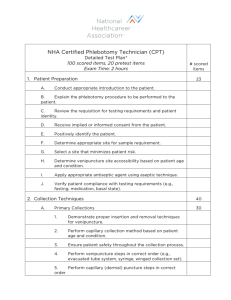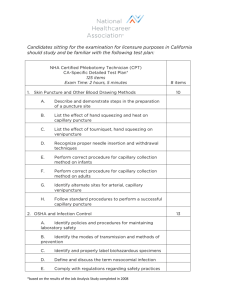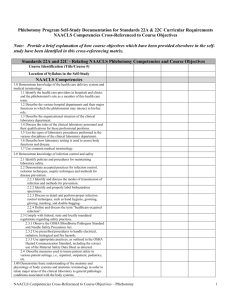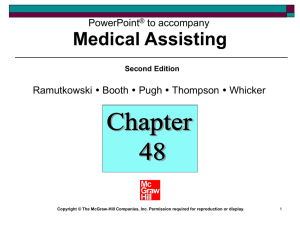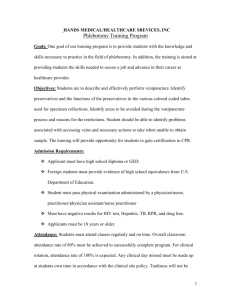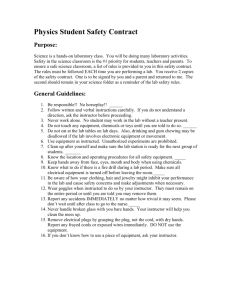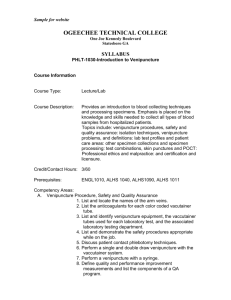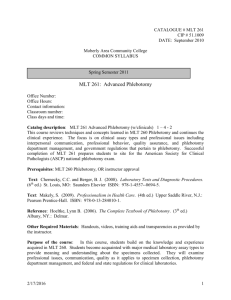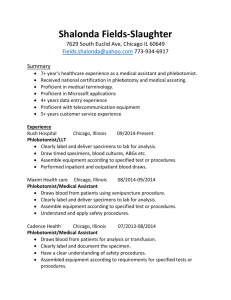Phlebotomy Tech - Casey County School District
advertisement
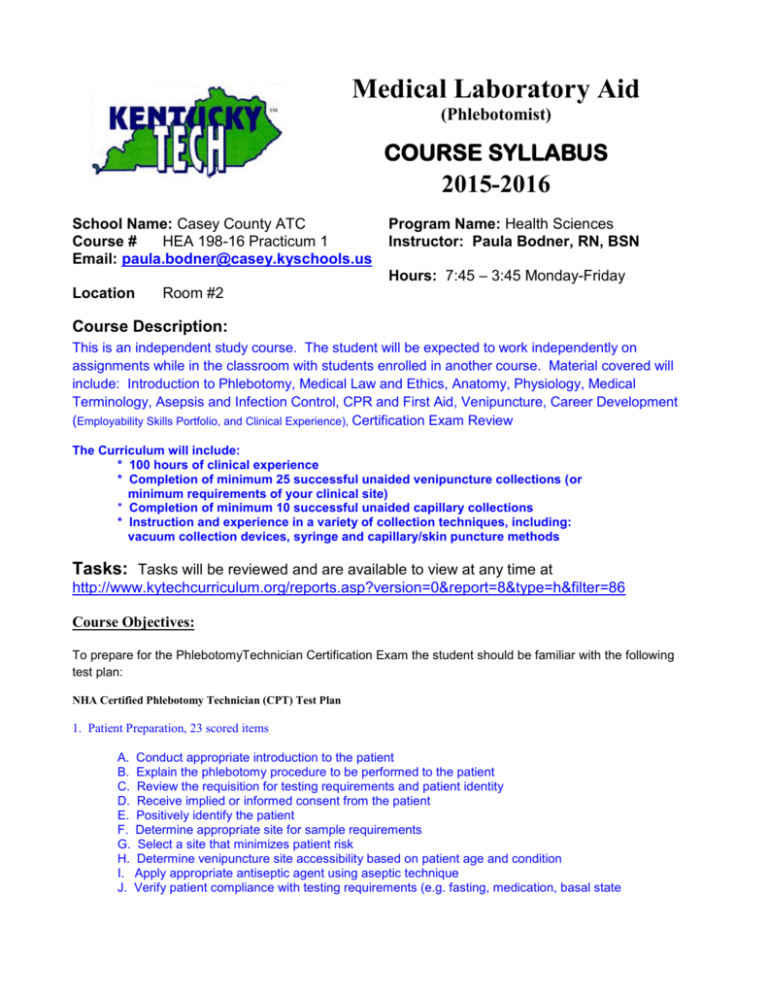
Medical Laboratory Aid (Phlebotomist) COURSE SYLLABUS 2015-2016 School Name: Casey County ATC Course # HEA 198-16 Practicum 1 Email: paula.bodner@casey.kyschools.us Program Name: Health Sciences Instructor: Paula Bodner, RN, BSN Hours: 7:45 – 3:45 Monday-Friday Location Room #2 Course Description: This is an independent study course. The student will be expected to work independently on assignments while in the classroom with students enrolled in another course. Material covered will include: Introduction to Phlebotomy, Medical Law and Ethics, Anatomy, Physiology, Medical Terminology, Asepsis and Infection Control, CPR and First Aid, Venipuncture, Career Development (Employability Skills Portfolio, and Clinical Experience), Certification Exam Review The Curriculum will include: * 100 hours of clinical experience * Completion of minimum 25 successful unaided venipuncture collections (or minimum requirements of your clinical site) * Completion of minimum 10 successful unaided capillary collections * Instruction and experience in a variety of collection techniques, including: vacuum collection devices, syringe and capillary/skin puncture methods Tasks: Tasks will be reviewed and are available to view at any time at http://www.kytechcurriculum.org/reports.asp?version=0&report=8&type=h&filter=86 Course Objectives: To prepare for the PhlebotomyTechnician Certification Exam the student should be familiar with the following test plan: NHA Certified Phlebotomy Technician (CPT) Test Plan 1. Patient Preparation, 23 scored items A. Conduct appropriate introduction to the patient B. Explain the phlebotomy procedure to be performed to the patient C. Review the requisition for testing requirements and patient identity D. Receive implied or informed consent from the patient E. Positively identify the patient F. Determine appropriate site for sample requirements G. Select a site that minimizes patient risk H. Determine venipuncture site accessibility based on patient age and condition I. Apply appropriate antiseptic agent using aseptic technique J. Verify patient compliance with testing requirements (e.g. fasting, medication, basal state 2. Collection Techniques, 40 scored items A. Primary Collections, 30 scored items 1. Demonstrate proper insertion and removal techniques for venipuncture 2. Perform capillary collection method based on patient age and condition 3. Ensure patient safety throughout the collection process 4. Perform venipuncture steps in correct order (e.g., evacuated tube system, syringe, winged collection set 5. Perform capillary (dermal) puncture steps in correct order 6. Recognize common complications from primary collection (e.g., lack of blood flow, hematoma, petechiae, nerve injury) 7. Identify problematic patient signs and symptoms throughout collection (e.g., syncope, diaphoresis, nausea, seizure) 8. Follow order of draw when performing venipuncture 9. Follow order of draw when performing capillary collection 10. Ensure that tube additives are appropriate for testing requirements 11. Assemble equipment needed for primary blood collection 12. Invert evacuated tubes with additive after collection 13. Verify quality of equipment (e.g., sterility, expiration date, manufacturer’s defects) B. Special Collections, 10 scored items 1. Prepare peripheral blood smears 2. Perform blood culture collections 3. Assist other healthcare professionals with blood culture collections 4. Collect blood samples for inborn errors of metabolism (e.g., PKU, galactosemia) 5. Perform phlebotomy for blood donations 6. Calculate volume requirements to avoid causing iatrogenic anemia 3. Processing, 27 scored items A. Label all specimens B. Perform quality control for CLIA-waived procedures C. Transport specimens based on handling requirements (e.g., temperature, light, time) D. Explain non-blood specimen collection procedures to patients (e.g., stool, urine, semen, sputum) E. Handle patient-collected non-blood specimens F. Avoid pre-analytical errors when collecting blood specimens (e.g., QNS, hemolysis) G. Adhere to chain of custody guidelines when required (e.g., forensic studies, blood alcohol, drug screen) H. Prepare samples for transportation to a reference (outside) laboratory I. Coordinate communication between non-laboratory personnel for processing and collection J. Use technology to input and retrieve specimen data K. Report critical values for point of care testing L. Distribute laboratory results to ordering providers 4. Safety and Compliance Considerations, 10 scored items A. Adhere to regulation regarding workplace safety (e.g., OSHA, NIOSH) B. Adhere to regulations regarding operational standards (e.g., JCAHO, CLSI) C. Adhere to HIPAA regulations regarding Protected Health Information (PHI) D. Follow exposure control plans in the event of occupational exposure E. Follow transmission based precautions (e.g., iatrogenic, airborne, droplet, contact) F. Wear personal protective equipment while following standard precautions (e.g., gloves, gowns, masks, shoe covers) G. Sanitize hands to prevent the spred of infections H. Initiate first aid when necessary I. Initiate CPR when necessary Materials Used: The Phlebotomy Handbook Blood Specimen Collection from Basic to Advanced 8th Edition Diana Garza and Kathleen Becan-McBride Course Outline Career Knowledge Gain career awareness and the opportunity to test career major choices(s) Name credentialing agencies for careers related to career major Trace the organizational structure of the career major and affiliating agency Research the history and rationale of career major specialty Identify the different specialties in the career major Demonstrate knowledge of applicable laws, statutes, or regulations in the career area Research common diseases or problems associated with career major Work Experience Receive work experience related to the medical laboratory aide career prior to graduation Integrate classroom studies with work experience Receive exposure to facilities and equipment unavailable in a classroom setting Increase employability potential after graduation Employability Skills Demonstrate performance skills related to the medical laboratory aide career Demonstrate knowledge of first aid and CPR as they relate to the area Demonstrate professional etiquette and responsibilities Demonstrate effective communication skills Practice team building concepts Demonstrate effective use of time management skills Incorporate use of related medical terminology and theory related to the Medical Laboratory Aide Demonstrate correct observation skills Safety Perform procedures to prevent disease transmission, utilizing OSHA, CDC regulations, and standard precautions Recognize and provide environmental, personal, and patient safety Follow safety, emergency and disaster procedures. Report unsafe conditions Specific Career Related Tasks Office Procedures Maintain confidentiality of patient and facility information Demonstrate proper use of the telephone, intercom system, copying, and faxing Receive patients and visitors Observe, record and report patient data Prepare accident, and incident reports as necessary Assist with data entry and billing procedures Treatment Procedures Identify supplies and equipment commonly used in lab procedures Assist with quality control checks of equipment Log incoming and outgoing specimens Deliver supplies and lab specimens to designated areas Prepare specimens for shipment Maintain lab work surfaces and glassware using proper cleaning and safety procedures Use appropriate sterilization procedures Maintain inventory Maintain routine lab chemical solutions. Label and store properly Prepare urine for microscopic examination Prepare and distribute 24 hour urine collection containers Differentiate between various kinds of collection tubes and anticoagulants Identify normal lab values for blood and urine Name the components of a complete blood count (CBC) Collect fluid or tissue specimens using appropriate collection procedures. Explain collection procedures to patients Match laboratory requisition forms to specimen tubes Document route of specimens from collection to laboratory analysis and diagnosis Assist and draw blood from capillaries by dermal puncture, such as heel or finger stick methods Assist and draw blood from veins by vacuum tube, syringe, or butterfly venipuncture methods Assist and draw blood from arteries, using arterial collection techniques Dispose of contaminated sharps, in accordance with applicable laws, standards, and policies Dispose of blood or other biohazard fluids or tissues, in accordance with applicable laws, standards, and policies Identify potential hazards in the lab Obtain a copy of MSDS sheets for materials used in the lab Explain the use of the safety shower and safety apparel Demonstrate procedure for use of the eyewash station Organize and clean blood-drawing trays, ensuring that all instruments are sterile and all needles, syringes or related items are of first-time use Clinical Guidelines A professional attitude and behavior must be maintained at all times during clinical rotations. Confidentiality must be maintained with no exceptions. IT IS HIPPA LAW! Unprofessional behavior or breach of confidentiality will be grounds for automatic dismissal from the Phlebotomy Technician program. Health care leaves no room for violations in either of these two areas. Information obtained at clinical sites must be kept in the strictest of confidence. Situations may be discussed within the class; however, no information is to be shared outside the classroom or clinical setting. Cell phones must not be carried on your person. A positive attitude and strong work ethic will be expected at all times when at the clinical sites. You will treat all staff and health care professionals with respect and courtesy. There will be no setting around in the lobby, break room, etc. You will work steadily for the length of time you are present at the clinical site. As there are a minimum of 100 clinical hours required, you may be requested to perform clinical rotations on weekends, after school and/or during holiday breaks. Your schedule will be determined by the Health Professional Mentor, the instructor and you. Once the schedule is set you will be expected to work during the scheduled times. If for some reason you must be absent you must call your mentor/supervisor, and the instructor in a timely manner that you will be absent. The first “no call, no show,” will be acknowledged with a written warning (with copies sent to parent/guardian). The second offence will result in cancellation of clinical rotation and grade for the course will be affected accordingly. Cancellation of clinical rotation for any cause (except with instructor permission; example: prolonged illness) will result in the student’s ban from further health science classes. Grading Student will be permitted to work at their own pace on textbook assignments and online student activities. However, suitable progress must be made throughout the course. Instructor will be available to answer questions and release exams once student has completed specific unit assignments. Grading Scale Grading Criteria A 90 - 100 40% Exams B 80 - 89 40% Performance C 70 - 79 20% Assignments/Projects D 60 - 69 F 0 - 59 I Incomplete National Healthcareer Association (NHA) Phlebotomy Certifcation You will not be eligible to receive an official certification until you are a high school graduate. However you may take the exam before graduation and receive a provisional certification at that time. The provisional certificate is then turned in for an official one after graduation. You must have written proof of successful completion of a training program and documentation of performance of 25 successful unaided venipuncture collection and 10 successful unaided capillary collections. You will be expected to schedule and assume the fee of $105 for taking the exam. It consists of 125 multiple choice questions that you have 2 hours and 10 minutes to complete. If you do not pass the exam the first time, you may retake it in 30 days. You have two chances to retake the exam. Candidates that are unsuccessful after these two attempts will be required to wait one year before testing again. A list of the Examination Content will be provided. Attendance Policy/Tardies Students are expected to attend class/clinical and be punctual. An absence is defined as coming to class/clinical or leaving class/clinical early by more than 15 minutes. Two episodes of tardiness or leaving early (less than 15 minutes) will be counted as an absence. Students accumulating more than five excused absences within any nineweek period will have two points deducted from class participation grade for each additional day absent over those five days. As participation is 10% of overall grade, excessive tardies or absences could result in drop of a letter grade during any nineweek period. Other Fees may be charged for field trips to cover the cost of transportation, tickets and/or registration. Dress Code On clinical days, you are to be dressed in clinical uniform (scrubs) with clean white socks, shoes, shoe strings etc. Uniform is to be clean and ironed. Hair should be up off the collar and jewelry should be kept to a minimum (no dangling earrings). Nails should be cut short and only clear or light pink nail polish is permitted. Absolutely no acrylic nails permitted. They could puncture gloves, injure patients, acquire bacteria, etc. Wearing sandals, flip flops, inappropriate uniform will result in student being sent to ACR (in school suspension). Class expectations/Rules 1. No talking while the instructor or other students are talking. We will conduct major discussions; however, only one person at a time will talk. 2. Snacks and drinks will be allowed in the classroom as long as garbage is disposed of and messes are not created. Should this happen, snack privileges will be terminated. 3. You are to be in the classroom and in your seat when the bell rings. If you need to go to the bathroom, get something to drink, etc. it must be done prior to the bell ringing. 4. Obey all safety rules and regulations. 5. Obey all high school rules and policies. 6. Only one student at a time will be permitted to leave the classroom to go to the restroom. The hall pass must be taken and returned to its proper place upon returning to the classroom. 7. Cheating or copying other’s homework will not be tolerated. Any assignment that the instructor has found the student cheating or copying, both the student and the 8. 9. 10. 11. 12. 13. 14. 15. 16. 17. 18. 19. 20. one allowing the copying will be given a zero. No horseplay, riding chairs, pushing, shoving, etc. All chairs are to be pushed in prior to leaving the classroom. You are not to enter the lab without the instructor’s permission. No lying around in the hospital beds during break times. Make sure the classroom/lab is cleaned and equipment and supplies are put away before leaving. If the lab is cluttered, we cannot work there safely. Watch your language! You cannot use foul and offensive language in the workplace; therefore, you cannot use it here! Be courteous to teachers and fellow students. There will be no talking about, gossiping, or mistreating fellow class members. We are family, thus we will show respect for one another as a family should. Professional attitude and behavior will be maintained at all times during class. We are training to be future health care providers and professional behavior must be practiced at all times. No cell phones, MP-3 players, IPods, etc. permitted in the classroom or clinical site. If you are carrying them in the classroom (they must not be on your person at the clinical site), they must be turned off and out of sight. No applying makeup during class. No video games, card playing, etc. in class. The computer stations are not to be used for surfing the net and playing computer games. Students will not be on the computer unless specific projects are assigned and computer use will be closely monitored. No hanging out in the bathrooms prior to or during class. You may be excused if it is an emergency but otherwise you should wait until breaks between classes. Accommodations for Individuals with Disabilities and Equal Employment Opportunities (EEO) The Education Cabinet, the Department for Workforce Investment and the Office of Career and Technical Education does not discriminate on the basis of race, color, national origin, sex, religion, age, or disability in educational services and/or employment. The Education Cabinet provides, upon request, reasonable accommodations including auxiliary aids and services necessary to afford an individual with a disability an equal opportunity to participate in all services, programs and activities. To request materials in an alternative format, contact the Civil Rights Compliance Coordinator in OCTE or Norb Ryan at NorbJ.Ryan@ky.gov. Persons with hearing-and speech- impairments can contact the agency by sing the Kentucky Relay Service, a toll-free telecommunication device for the deaf (TDD). For voice to TDD, call 1-800—648-6057. For TDD to voice, call 1-800-648-6056. The Office of Career and Technical Education does not discriminate on the basis of race, color, national origin, sex, disability, age, marital status, or religion in admission to education programs, activities, and employment practices in accordance with Title VI of the Civil Rights Act of 1964, Title VII of the Civil Rights Act of 1964, Title IX of the Educational Amendments of 1972, Section 504 of the Rehabilitation Act of 1973 (revised 1992), and the Americans with Disabilities Act of 1990 and shall provide, upon request by a qualified disabled individual, reasonable accommodations including auxiliary aids and services necessary to afford individuals with a disability an equal opportunity to participate. For more information, contact Mr. William Denton, Office of Career and Technical Education, 20th Floor CPT, Frankfort, Kentucky 40601, (502) 564-4286. Mr. Denton can also be reached through his e-mail address: WilliamJ.Denton@ky.gov. __________________________________________ Student Signature ________________ Date __________________________________________ Parent/Guardian Signature ________________ Date I have completed the Safety Orientation for the Health Science program, and certify that I understand all the safety regulations pertaining to it. This orientation included the physical and chemical dangers (cleaners, paints, thinners, solvents, etc. . .) to which I may be exposed while in this shop/classroom as required by the Hazardous Communication Standard; power tool and equipment safety; and general classroom/shop safety. I also understand that I am now under a DIRECT ORDER not to use ANY tools and/or chemicals until and unless the instructor has given permission. I have also been told that to use such tools and/or chemicals without permission will result in disciplinary action. I have received training in the following: ( ) The location of the Hazardous Chemical list and SDS sheets in my classroom/shop area. ( ) How to find and use the corresponding SDS sheets from the hazardous chemical list as part of my safety orientation or in the event of an accident. ( ) I have been instructed on the safe and proper use of the items found on the chemical list in my shop/area classroom. ( ) I know the location of, and have instruction in the safe use of the required personal protective equipment (PPE) for the items listed on the chemical list as well as any tools/equipment. ( ) I have informed my parents about the hazardous communication program, and informed them that the program is available for their scrutiny upon appointment. ( ) I have been shown the location of all fire extinguishers in or near the shop and shown how to use each type. ( ) I have been instructed on Blood Bourne Pathogens and understand to treat all body fluids as being infectious. ( ) I have been instructed on the potential for needle sticks and the protocol associated with the phlebotomy and/or MNA programs for sharps injury. ( ) I have been instructed and have performed a walk thru of all exits and emergency routes and protocols. ( ) I have been instructed how to obtain this syllabus from the district web site. (Hard copies are available upon request). Parent Signature Date Student Signature Date
